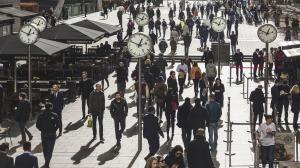
AM and PM Explained
How does the 12-hour clock system work? Is midnight 12 am or 12 pm?
Holy Saturday is the day between Jesus Christ's crucifixion (Good Friday) and his resurrection (Easter Sunday), according to Christian belief. Many Orthodox Christians commemorate the burial of Christ on this day.

As midnight approaches, Orthodox worshippers light candles, and church bells announce the resurrection of Christ at midnight.
©iStockphoto.com/Sviatlana Lazarenka
Holy Communion can be received on Holy Saturday morning in some Orthodox churches in countries such as the United States. Some churches hold a midnight liturgy between Holy Saturday and Easter Sunday.
In Greece, Holy Saturday is filled with the anticipation of celebrating Easter Sunday. In some areas, people begin to gather in the churches and squares in cities, towns and villages by 11pm for the Easter liturgies. Many people carry large white candles and the church bells toll as the priests announce “Christ is Risen!” at midnight between Holy Saturday and Easter Sunday. Fireworks are set off and each person in the crowd responds with set joyous responses. After this, everybody goes home for a meal – the fasting period is over. If their candles are still burning, a cross is made in the doorway with the soot to protect the house for the coming year.
An Easter liturgy is also held on Saturday night in many Russian Orthodox churches. Worshippers congregate in a darkened church. As midnight approaches, worshippers light candles and church bells announce the resurrection of Christ at midnight. An intensely joyful Orthodox liturgical chant can be heard throughout the streets in some parts of Russia until the conclusion of Easter liturgy at dawn.
In Lebanon, which also observes the Orthodox Easter, it is traditional that on the afternoon of Easter Saturday people visit seven churches to be blessed at each of them. Some people place a piece of dough in a tree on Saturday night, believing it will be blessed by Christ. On Sunday evening they place small pieces of that dough in other food containers so that these will also become blessed.
Many people flock to the Church of the Holy Sepulchre in Jerusalem, which is believed to be the site of Jesus Christ's burial, on Holy Saturday. They come to this place to experience an annual event, which is deemed as a miracle, known as the Holy Fire. According to many Orthodox Christian sources, this fire occurs annually at the same place and time, and in the same manner. The Holy Fire liturgy is broadcast live in countries such as Greece and Russia.
The Easter period is officially observed in countries including: Bulgaria, Cyprus, Greece, Lebanon, Republic of Macedonia, Romania and Ukraine. There are no federal Orthodox Holy Saturday public holidays in countries such as Australia, Canada, the United Kingdom, and the United States. However, it is a time for families and friends of the Orthodox Christian faith to gather together and to celebrate the Orthodox Easter period.
Holy Saturday is the day between Jesus’ death and his resurrection. Many Orthodox churches contemplate the mystery of Jesus Christ’s descent into Hades, the world of the dead. According to the story of Christ’s death and resurrection, death is defeated from within. It is the day of watchful expectation when mourning is transformed into joy. Holy Saturday is part of the Easter period observed by both Orthodox and western churches alike, although Easter dates often tend to differ between the churches.
The Council of Nicaea established the Easter date for churches around the world in 325CE but not all Christian churches observed Easter according the Gregorian calendar after it was first introduced in 1582. Many Orthodox churches still observe Easter in accordance with the Julian calendar. Therefore the Orthodox Easter period occurs later than the Easter period that falls around the time of the March equinox.
In the Orthodox circles, tensions exist between New Calendarists – those who use the revised Julian calendar for calculating the feasts of the ecclesiastical year – and Old Calendarists – those who continue to use the traditional Julian calendar. There have been a number of proposed Easter date reforms. In 1997 the World Council of Churches proposed a reform to solve the Easter date difference between churches that observe the Gregorian calendar and those that observe the Julian calendar. So far, this reform has not been implemented.
The tomb of Christ is an important symbol on Holy Saturday – it is no ordinary grave because it does not represent a place of corruption, decay and defeat. It is life-giving, a source of power, victory and liberation.
During Holy Saturday it is customary for the clergy and people to hold candles during the singing of the Lamentations and at the procession of the Epitaphios, an icon most often found as a large cloth, embroidered and often richly adorned,. This practice is rooted in ancient Christian burial practices. Candles are lit to symbolize the victory of Christ over death, and to express as well the church's belief in Christ’s resurrection.
In many Russian Orthodox churches, the darkened church on Holy Saturday symbolizes the despair of a world without faith in Jesus Christ. Historically, the eve of Holy Saturday was considered a haunted time when satanic creatures tormented townsmen. People were afraid to go out after dark, but persevered to attend a liturgy because the church was considered a safe haven. As midnight approaches, candles are lit and, at midnight, church bells ring as a symbol of Christ’s resurrection.

How does the 12-hour clock system work? Is midnight 12 am or 12 pm?

Why do many countries set the clocks back and forth an hour twice a year?

Why are there 12 months? How long are they, and what do the month names mean?

Coordinated Universal Time (UTC) is the basis for civil time today. This 24-hour time standard is kept using highly precise atomic clocks combined with the Earth's rotation.